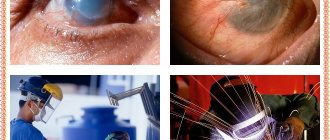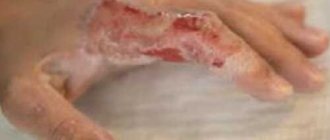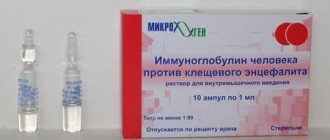What to do if a speck gets into your eye - first aid for an adult or child
Before starting any therapeutic measures to remove a foreign body at home, you need to assess the nature of its placement.
If the speck is localized on the inside of the upper/lower eyelid, on the surface of the eye, you can try to pull it out yourself.
If the organ of vision is damaged, as well as in cases where a foreign body has stuck into it, you should immediately consult an ophthalmologist!
First aid algorithm for removing specks from the outer part of the eye in an adult:
- Initially, you should find a well-lit room with a mirror and examine the outside of the eye. At this stage, it is important to determine the location of this speck and its nature (sand, eyelash, shavings, etc.).
- If a superficial examination turns out to be inconclusive, you need to rotate the eyeball, or blink , loosely squeezing your eyelids, until tears appear. In some cases, such manipulation helps the speck to come out. You can also run your finger along your closed eyelids in the direction from the temple to the bridge of the nose. Do not rub your eyelids too vigorously: this may cause injury to the eye.
- If the above procedures are ineffective, you can try taking water into your palms or an iron bowl, lowering your face into it with your eyes open and try blinking. As an alternative, you can use a small syringe or syringe filled with water to gently rinse the eye.
- If the speck is “hidden” behind the upper eyelid, it should be pulled towards the lower eyelid, while the eyes should be lowered down. This may expel the foreign body into the middle of the eye.
- from the lower eyelid using a handkerchief folded in a corner, a cotton pad, or a paper napkin. The cotton swab must be moistened before use.
- After removing the speck, you need to drop antiseptics into the eye: Tsiprolet, Okomestin so that the liquid comes out. If anti-inflammatory eye drops are not available, you can use chilled boiled water.
- If shavings get into your eyes, you should not close your eyes: the upper and lower eyelids are examined using a cotton swab, which is placed vertically in the middle of the eyelid. With the other hand you need to pull the eyelashes, causing the eyelid to evert out. Next, a syringe with water will be useful: you can use it to wash the shavings. Instilling eye anesthetics into the eyes will help temporarily relieve discomfort. After these activities, you should in any case see an ophthalmologist!
- Sometimes, after removing a foreign body from the surface of the eye, the victim continues to feel discomfort. A similar phenomenon can occur if a foreign body scratches the mucous membrane of the eye. In such situations, you should also use antiseptic drops.
Removing debris from under the upper eyelid
Removing a foreign body from under the lower eyelid
For young children, the most pressing problem is sand getting into their eyes. Therefore, parents who are going to the playground with their child every time should put alcohol-free wet wipes and a bottle of water in their bag.
If your baby gets sand in his eyes, you need to do the following:
- Shake the sand off the face and rinse the child's hands with water or wipe them with a damp cloth.
- Upon arrival home, your eyes should be rinsed with water for 15 minutes . If a child cries, do not pay attention to it: tears facilitate the release of sand.
- At the end of the procedure, antiseptic drops (Vigamox, Okomestin) should be placed in the baby’s eyes.
Signs that debris has gotten into your eye
The most common situation in which the eye is damaged is the entry of a foreign body with irregular edges.
A variety of foreign bodies that fall on the apple of the eye can damage the eye. Even the slightest injury to the eye is dangerous to a person.
If a speck gets into the eye, the person will feel discomfort, which may be accompanied by itching, burning, and profuse tearing. In rare cases, bleeding may occur. He will try to get the speck. Before you remove a speck from your eye, you need to make sure that it is the speck that causes the discomfort.
Many people get confused and don’t know what to do if they get sand in their eyes. If you cannot remove the “grain of sand” from your eye on your own, you need to consult a doctor. With timely assistance, vision problems can be avoided in the future.
There are cases when it is not possible to remove a speck from your eye. We are talking about debris getting into the cornea.
What not to do if there is a foreign body in the eye - pay attention!
In this situation, some actions can worsen the structure of the organ of vision:
- Strong rubbing of the eye in attempts to remove specks. This procedure can harm the conjunctiva and cornea.
- Removing metal shavings from the surface of the eye using a magnet, tweezers or a cotton pad. In the same case, if the metal was removed by washing with water, the victim should still be examined by an ophthalmologist.
- Instillation of the eyes with honey, aloe juice , or other means recommended by traditional medicine.
- Trying to remove a piece of glass or a large grain of sand from the surface of the eye - especially if it is stuck in the iris of the organ of vision. In such cases, you should not squint your eyes too much or blink frequently. The victim should cover the sore eye with a sterile napkin and immediately go to the hospital!
Foreign body of the conjunctiva
Depending on the force of the flight, foreign bodies that fall on the conjunctiva remain on its surface or are embedded in its tissue, causing not only discomfort in the patient, but also serious complications that, without adequate treatment, can lead to irreversible loss of vision.
Usually these are small particles:
- land,
- grains of sand
- coal particles,
- stone,
- metal,
- hairs of some caterpillars,
- hard hairs of cereal plants,
- burdock, etc.
A foreign body violates the integrity of the conjunctival epithelium. When introduced into the conjunctiva, an infiltrate appears around the foreign body. Caterpillar hairs embedded in the conjunctival tissue after a few days cause the development of granulations that resemble tuberculous lesions of the conjunctiva. Granulations consist of lymphocytes, epithelioid and giant cells.
Symptoms
A foreign body of the conjunctiva causes irritation of the eye - photophobia, blepharospasm, pain, foreign body sensation. With focal illumination or biomicroscopy, a foreign body lying on the conjunctiva or embedded in its tissue is determined. Conjunctival injection of the eye is expressed to varying degrees. Thanks to reflex blinking movements and increased tear production, a foreign body can move and most often linger on the inner surface of the eyelid in a groove running along the edge of the eyelid. It is therefore necessary to turn out the upper eyelid and carefully examine its mucous membrane, as well as the transitional fold. When hairs from cereal plants and burdocks penetrate into the conjunctiva, severe irritation of the eye occurs. When the eyelid is everted, a limited inflammatory focus is found on the conjunctiva with the development of papillae, in the center of which there is a hair. Often this hair causes desquamation of the epithelium of the corresponding area of the cornea.
Diagnostics
The diagnosis is not difficult and is made on the basis of anamnesis, the phenomenon of eye irritation and the detection of a foreign body when examining the conjunctiva, incl. using a slit lamp.
Recommendations for patients after removing a speck from the eye
If you remove the speck yourself, the victim should rinse his eyes with chamomile decoction or weak tea .
To prepare an antiseptic decoction, pour 3 tbsp. chamomile inflorescences with a glass of boiling water and leave for 1-2 hours.
For a similar procedure, you can purchase anti-inflammatory eye drops .
If there remains severe discomfort after removing the speck yourself, lacrimation, or pain, you should immediately consult an ophthalmologist!
- When removing a foreign body from the surface of the eye on an outpatient basis, upon returning home, the patient must promptly instill drops into the affected eye or place a special ointment (as prescribed by the doctor).
- When going outside, it is imperative to cover the sore area with a special bandage .
- For the first 5 days after treatment in the clinic, you should refrain from playing sports, visiting swimming pools, and saunas.
Rate
—
https://youtu.be/-kqbIrOVLiA
What is the danger of a foreign object getting into the eye?
Foreign elements in the organ of vision cause toxic or mechanical damage, as well as inflammatory reactions (blepharitis, keratitis, conjunctivitis, uveitis), hemorrhages and secondary complications.
It is considered safest to find a foreign body in the conjunctival sac. If the object is sharp, it easily penetrates the cornea or sclera. And if he flew at high speed, then they are damaged.
If a foreign body in the eye is iron or copper, a nuisance such as metallosis often occurs, which is a chemical reaction with the tissues of the eye. Its danger lies in the fact that visual acuity begins to decrease, twilight blindness may occur, the field of vision narrows, and other symptoms appear. If a foreign object remains in the eye for a long time, very serious complications can arise.
Causes and possible diseases
The sensation of a foreign body in the eye is caused either by external irritants or by an eye disease.
https://youtu.be/B-KlDDjeZTY
External incentives
External irritants that can cause a foreign body sensation in the eye:
- Foreign substances: insect, grain of sand, dust, eyelashes, wood, glass, metal fragments,
- Smoke,
- Computer work,
- Bad light,
- Bright sunlight.
Eye diseases
Sometimes the sensation of a foreign body in the eye is associated with an eye disease:
- Conjunctivitis,
- Blepharitis,
- Inflammation of the cornea (keratitis),
- Vascular inflammation (uveitis),
- Inflammation of the dermis (scleritis),
- Barley (Chalazion),
- Dry eyes/impaired hydration (too few tears).
Classification
Such injuries are divided according to the degree of penetration into:
- superficial (including specks) – foreign objects are fixed on the outer part of the eyeball and can be detected when examined with the naked eye;
- intraocular - foreign objects are retained in the internal parts of the organs of vision, passing through the outer membranes.
Foreign bodies also differ in their location around:
- century;
- corneal tissue;
- conjunctiva;
- eyeball;
- eye sockets.
Also, alien objects are divided into two large groups, in which the determining factor is the composition:
- Magnetic or iron-containing. This includes objects that have the ability to attract objects using a magnetic field (metal shavings, iron wire, pieces of iron-containing alloys).
- Non-magnetic. These bodies do not have magnetic properties (wood chips, glass shards, pieces of objects made of copper, aluminum and other dielectric metals, particles of earth, sand).
Diagnostics
Primary diagnosis is ophthalmoscopy. Using an ophthalmoscope and fundus lens, the doctor examines the fundus of the eye, blood vessels, and evaluates various structures of the eye. If visible causes are not identified (neoplasm, inflammatory process, violation of tissue integrity), a more detailed examination of the patient is carried out using ophthalmological equipment.
A slit lamp is used for diagnosis. They study the surface of the eyeball, internal structures - the retina, lens, iris, optic nerve.
To identify microparticles, fluorescent staining of the mucous membrane is used and viewed under a UV lamp.
For a more detailed diagnosis, the patient is sent for an ultrasound or MRI.
If ophthalmological studies do not reveal the cause of the pathological condition, the person undergoes a comprehensive diagnosis of the body to detect internal chronic diseases.
Prevention
Preventive measures to prevent foreign particles from getting into the eyes include observing personal hygiene and safety regulations at work. If work involves operating a machine, be sure to wear safety glasses. Young children require constant supervision, and older ones are advised to explain the rules of personal hygiene.
Folk remedies
Alternative medicine products are very popular at home. The most effective are decoctions and infusions of medicinal herbs.
Naturopaths recommend using the following folk remedies:
- Black tea leaves. Tea leaves are the most accessible and used means. To carry out the manipulations, you need to brew light strength tea.
- Dill greens. It is used as a mono remedy and as a component of a healing decoction. The easiest way is to squeeze the juice from the fresh leaves of the plant and rinse your eyes.
- Propolis water. To prepare it, you need to grind dried propolis flowers and pour a glass of warm water. Leave for a couple of hours.
- Rose hip. Mix 35 g of crushed berries of the plant with 200 ml of boiling water and simmer over low heat for 5 minutes. Remove from heat, cover tightly and leave for half an hour.
- Medicinal chamomile. Based on it, an infusion is prepared that effectively relieves inflammation. To prepare the infusion, pour 10 g of raw material into a glass of water, close the lid and leave for 40 minutes.
- Bay leaf. Washing is carried out with infusion. To prepare it, pour 2-3 small bay leaves into 200 ml of boiling water and leave for 1 hour.
All natural remedies have a number of contraindications that must be taken into account when rinsing with medications based on them.
Main reasons
Often the patient complains that brake fluid, a hard object or other dangerous substances have gotten into the eye, causing eye pain. At risk are people engaged in certain work, which can cause damage to the cornea, eyeball and other structures of the visual organs. Foreign bodies are most often observed in the ears and eyes in the following groups of workers:
People involved in mechanical processing of wood are primarily susceptible to the penetration of specks and damage to the cornea.
- lumberjacks;
- carpenters;
- carpenters;
- welders.
A child or an adult can be hit by a speck of dust during strong gusts of wind or during a dust storm. When you move quickly on a bicycle or other open vehicle, there is a high probability of a foreign object appearing in the ear or eyeball. Often a person notices that a midge has entered the eye, resulting in discomfort and redness. Similar unpleasant sensations can occur in people who use contact lenses daily. The cause of unpleasant feelings in the eyes is also due to insufficient hygiene.
Symptoms
Symptoms indicating the presence of foreign bodies in the eye range from mild discomfort to severe, high-intensity pain. First of all, there is a dependence of the degree of pain on the location of the foreign particle and the nature of the damage.
Superficial eye damage often manifests itself as:
- discomfort;
- pain in the eye area;
- lacrimation;
- redness of the protein membrane;
- burning sensations;
- scratches on the eyes;
- hypersensitivity to light;
- problems associated with opening the eyelids;
- swelling of the soft eye tissues;
- the presence of a foggy cloud in the field of view;
- bleeding of vessels located close to the surface.
When foreign bodies penetrate into the inner parts of the eyes, these symptoms appear stronger and more often.
Occasionally, when a small sharp foreign object is ingested, symptoms are almost completely absent or their number and degree of manifestation are minimal.
In a situation where the patient does not complain of various types of pain, but suspects that a foreign particle has entered the eye, he should immediately go to see a doctor. He will prescribe the appropriate diagnostic procedures, since sometimes the location of a given object is quite difficult to determine during examination without ophthalmological equipment.
What to do when a symptom appears?
If you feel a foreign object in the eye, do not rub or scratch your eyelids or hold back tears. If you feel as if something has gotten into your eye, try to remove the foreign body with a cotton swab or by rinsing with water. You can wash your eyesight in the following ways:
- blink, lowering your eyes into a container of water;
- pour water from a bottle into the eye and let it drain;
- Rinse the eye organ with a weak pressure from the syringe.
Only a doctor should remove stuck foreign bodies.
After removing the foreign object, you can drip Visine and Systane drops to relieve irritation. To prevent infectious complications, eye drops “Albucid” and “Levomycetin” are prescribed.
If the pain, discomfort and feeling that something is in the eye are not directly related to a foreign body, then another treatment will be required:
- Bacterial infections: drops "Floxal", "Albucid", ointments "Tobrex", "Tetracycline".
- Viral pathologies: antiviral drops “Ophthalmoferon”, “Aktipol”, ointments for herpes “Acyclovir”, “Zovirax”.
- To moisturize and relieve inflammatory manifestations of xerophthalmia, after injuries, burns, operations, moisturizing drops are prescribed: “Ophtolik”, “Vizin”, “Systane”.
- For glaucoma, drops that reduce IOP are prescribed: “Betoptik”, “Travatan”.
- In case of pterygium or neoplasm, surgical removal is performed.
- In case of an ingrown eyelash, it is removed and the adjacent tissues are treated with antiseptic.
Additionally, see the story on how to remove a foreign body from the eye:
https://youtu.be/v07eAwsR8IY
What to do, what examinations need to be completed
Correct diagnosis is the first step towards effective treatment. External examination does not always give a complete picture of the course of the disease.
, a slit lamp and an ophthalmoscope are a powerful tool for identifying certain diseases and detecting a foreign body.
We use fluorescent dyes that are safe for health and visible under ultraviolet irradiation.
They allow you to detect foreign particles invisible in normal light. But in some cases, a more detailed study of all indicators is necessary.
The doctor can write a referral for an MRI, ultrasound, or smear test . The test results and examination data will form the basis of the treatment strategy.
Treatment
After confirming the presence of a foreign object in the eye, the doctor removes it using a clean, damp swab. Anesthesia is carried out first; most often, Dicaine drops or other medications with analgesic properties are used.
https://youtu.be/TdOt_AEb23A
If difficulties arise in the process of detecting a foreign object due to its small size, special drops with fluorescein are used. After the dye is injected into the eyes, its outline appears, after which the doctor removes the object.
Accidental damage to the cornea is treated with a special ointment with antibacterial properties. Severe damage to the cornea can be cured with the help of special drops to dilate the pupils, as well as drops with antibacterial properties. It takes 2-3 days to eliminate minor damage, and 7 days to get rid of severe damage.
It is recommended to wear a special bandage on the damaged eye to protect against the penetration of light rays. If a foreign object gets into the eye, surgical intervention is prescribed. The operation should be performed as early as possible, this will help to avoid infection and a decrease in visual function up to the complete loss.
Why is it dangerous
If a foreign object enters the eye area, it can cause injury of both a toxic and mechanical nature. Inflammatory processes also often appear, manifested in the form of:
- conjunctivitis;
- blepharitis;
- uveitis;
- keratitis.
Sometimes hemorrhages and secondary complications are observed. All these factors often lead to retinal detachment, glaucoma, cataracts and other pathologies of the visual system.
The degree of danger from a foreign object depends on various factors. The main ones are:
- object shape;
- compound;
- the amount of substance entering the eye;
- location;
- duration of stay in the eye.
The safest case is when the foreign object enters the conjunctival sac and does not have sharp ends. Otherwise, penetration into the sclerotic membrane or corneal tissue may occur.
Possible problems
The reasons for the appearance of unpleasant symptoms can be very different. Doctors identify the following types of injuries:
- mechanical and toxic;
- inflammatory diseases;
- hemorrhages;
- secondary complications.
Based on the location where the hit object was found, the following affected areas are distinguished:
- eyelids;
- cornea;
- eye socket;
- eyeball;
- conjunctiva.
Types of eye injuries
Structural damage occurs from the moment an object enters the eye until it is removed. If it is left for a long time, toxic damage may develop. They directly depend on the composition of the object, the location and depth of its penetration.
Foreign particles in the cornea remain on top of it or get inside. If the epithelium is damaged, after several hours an inflammatory process can be observed in the tissues.
When should you see a doctor?
If the foreign body sensation in the eye is actually caused by a foreign body and persists after it is removed, the cornea is likely damaged. This so-called corneal erosion should be examined by a doctor.
Foreign objects that cannot be removed by rinsing (especially shards of metal, wood or glass) and other sharp objects lodged in the eyeball are an ophthalmic emergency. You should remain calm, cover your eyes as much as possible, and visit an eye care emergency room.
You may also experience a persistent sensation of a foreign body in the eye, accompanied by severe redness and burning in the eyes, without the foreign body being detected. Consult an ophthalmologist; this may be inflammation or another eye disease. If left untreated, vision may be impaired.
How and what to wash
Do not rinse with alcohol-based products. This will only lead to tissue burns, which will negatively affect the condition of the visual organs. If you have absolutely no ingredients on hand, you can simply rinse your eyes with water in any way convenient for you. It is advisable that the water be boiled. This will avoid possible contamination by bacteria that may live in it.
Do not wash your eyes with water that has not undergone sanitary treatment (from springs in forests, etc.). There is a high probability of contamination of such sources with microorganisms, which, if they enter the injured eye, can remain there, and then the person will have more serious problems than the symptoms of conjunctivitis. This method of washing is suitable only in cases where it is necessary to get rid of caustic chemical components (salts, alkali, acid). However, in the near future it is necessary to urgently consult a doctor for qualified help.
Finally, it is necessary to pay attention to the hygiene of the process itself. A person's hands must be absolutely clean. The cotton wool that has just been used to wash one eye cannot be used again (including for the other eye). This may lead to the spread of infection. And of course, it is necessary to monitor the expiration date of the compositions. It is better to prepare home remedies fresh and store them for no more than a day. The most popular remedy, saline, is stored for no more than 24 hours after opening, but there are ways to increase this period. In this case, you must not open the bottle cap. The required amount of the composition is taken by pulling it out of the syringe, piercing the rubber cap.
Eye rinsing is a procedure that can make therapy more effective and speed up healing for some eye diseases. It must be carried out correctly in order to help and not harm the organs of vision.
Associated symptoms
The feeling of a speck in the eye is often accompanied by the following additional symptoms:
Often this sensation is combined with a headache.
- increased lacrimation;
- pain, itching, burning, tingling, as if the mucous membrane is irritated by an eyelash or other sharp object;
- photophobia;
- hyperemia;
- decreased vision clarity, blurred vision;
- blepharospasm;
- discharge of pus;
- headache.
Carrying out diagnostics
- When the patient is admitted to a specialist, the doctor begins to conduct diagnostics to determine visual acuity and the presence of damage to the eye membranes.
- If the patient still has a foreign body in the eye or suspects it, the doctor will invert the upper eyelid and check the eye.
- If the patient’s testimony indicates that some particles are located in the intraocular space, then the doctor makes a diagnosis using an ophthalmoscope, radiography, and ultrasound.
First aid if a foreign body gets under the skin
One of the most common skin injuries is splinters. Under various circumstances, wood chips, glass shards, metal shavings, etc. can get into the skin. To remove them you need to follow certain rules:
- Before removing a splinter, you need to wash your hands with soap;
- the site of splinter penetration can be treated with any disinfectant solution (alcohol, iodine);
- if part of the splinter remains on the surface of the skin, it can be removed with tweezers and the wound can be wiped with alcohol;
- if the splinter has completely entered the skin, then you should take a sterile needle from a disposable syringe (it can be replaced with a fire-heated sewing needle), pry the skin over the splinter, tear it, remove the splinter with tweezers and disinfect the wound;
- after all manipulations, to prevent infection, you can apply Baneocin powder or ointment to the wound;
- If the splinter cannot be removed or the skin at the site of its insertion has festered, you should contact a surgeon at the clinic.











